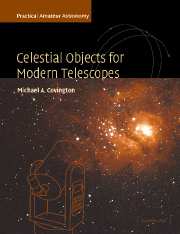Book contents
- Frontmatter
- Contents
- Preface
- Part I Amateur astronomy
- Part II 200 interesting stars and deep-sky objects
- 12 How these objects were chosen
- 13 The January–February sky (R.A. 6h–10h)
- 14 The March–April sky (R.A. 10h–14h)
- 15 The May–June sky (R.A. 14h–18h)
- 16 The July–August sky (R.A. 18h–22h)
- 17 The September–October sky (R.A. 22h–2h)
- 18 The November–December sky (R.A. 2h–6h)
- Appendices
- Index
12 - How these objects were chosen
Published online by Cambridge University Press: 22 September 2009
- Frontmatter
- Contents
- Preface
- Part I Amateur astronomy
- Part II 200 interesting stars and deep-sky objects
- 12 How these objects were chosen
- 13 The January–February sky (R.A. 6h–10h)
- 14 The March–April sky (R.A. 10h–14h)
- 15 The May–June sky (R.A. 14h–18h)
- 16 The July–August sky (R.A. 18h–22h)
- 17 The September–October sky (R.A. 22h–2h)
- 18 The November–December sky (R.A. 2h–6h)
- Appendices
- Index
Summary
Back in the 1850s, T. W. Webb noticed that amateur astronomy had become competitive – his contemporaries were trying to outdo each other by building larger and larger reflectors. He decided to break out of this trend and write a book for owners of 3-inch refractors and the like. His book, Celestial Objects for Common Telescopes, has become a classic and is still available.
In a similar spirit, I want to break away from the present-day tendency to equate deep-sky observing with star-hopping to the faintest possible nebulae and galaxies, which are visible only under extremely dark skies. There's more to the stellar universe than just “faint fuzzies.”
The objects in this list are visible with an 8-inch (20-cm) telescope under suburban skies with a naked-eye magnitude limit of 5. Most of them are fine sights even with considerably smaller telescopes under worse conditions. Many of them are stars (variable, double, multiple, or unusually colored) or bright star clusters.
This list is based on my own observations. It is organized by zones of right ascension, and within each zone, in sequence from north to south. Chapter titles such as “The January–February sky” refer to the time of year when the objects are highest at 10 or 11 p.m. local time. Many of the objects, especially the more northerly ones, can be viewed for much longer than just the specified two-month period. Those in the extreme south, however, are in the sky only briefly.
- Type
- Chapter
- Information
- Celestial Objects for Modern TelescopesPractical Amateur Astronomy Volume 2, pp. 167 - 170Publisher: Cambridge University PressPrint publication year: 2002



